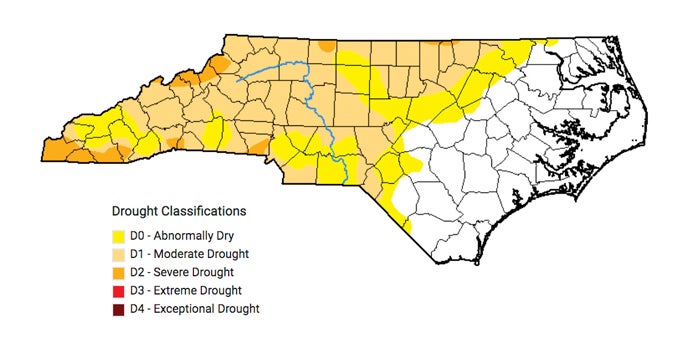Temperatures cool as growers continue to cope with drought
Published 12:10 am Sunday, October 6, 2019
By Liz Moomey
liz.moomey@salisburypost.com
SALISBURY — A year ago, Rowan County was between two hurricanes that dumped a number of inches of rain on this region. This year, it hasn’t rained much since Aug. 24 — just 0.3 of an inch — and the heat continued last week into the mid-90s.
According to U.S. Drought Monitor, the county is in a moderate drought along with 47 other counties. Nine counties in the state are considered to be in a severe drought.
“Another week of little to no rainfall and record high temperatures has led to worsening drought conditions,” said Klaus Albertin, chairman of the N.C. Drought Management Advisory Council. “If the forecast holds, the entire state may experience drought or dry conditions by mid-October.”
Teresa Herman, superintendent of the Piedmont Research Station, said the staff there is praying for rain. The region needs a week of drizzling, constant rain, she said.
“We’re in a perfect storm of heat and dry,” Herman said.
The lack of rainfall, Herman said, caused the dry soil to heat up.
And it’s not only are people who are tired of the heat. Animals are as well. Luckily, weather on Saturday offered a respite from the heat, with temperatures in the 60s, and the 90-degree temperatures of recent memory are absent from 10-day forecasts.
David Correll, of Correll Farms, said the drought has been only part of the problem; the other part is the “darn heat.”
The heat has been particularly challenging for growing tomatoes, which struggle if the temperature doesn’t get below 70 degrees. Correll said when weather conditions are stressful, the fruit may not mature properly.
“We have some time for the plants to settle back into their growing pattern,” Correll said.
The continued heat across the South has meant more competition from growers in the northern part on the country who are still able to produce crops. Correll said the produce market is depressed, and that tomatoes are continuing to grow in areas like New York that should be done for the season.
The weather also has affected the size of soybeans. Smaller beans mean farmers have to put more of them in a bushel to reach 60 pounds. The soybeans on Correll’s farms are half the size they would be in a typical season.
“The only difference between making money and losing money is rain,” Correll said.
Amy-Lynn Albertson, Rowan County Extension director, said the dry weather also has created an increased number of fire hazards in the field. Fire departments have responded to field fires as farmers are harvesting corn. In one fire, a farmer can lose $500,000 in equipment, she said.
Albertson recommened that farmers keep a fire extinguisher on each vehicle in the field, take time to cool down equipment and ensure that equipment is property greased. A fire can be started with one spark, she says.
Last year, weather caused other problems. Fall brought lots of rain that caused disease and lower-quality fruit.
“It’s farming,”Albertson said. “It’s a different set of challenges every year.”
Albertson said a season can be ruined by one big storm or a drought.
“Farmers are the biggest risk takers that you will ever see,” Albertson said.
She says it’s especially hard for farmers when extreme weather events are closer and closer and don’t give farmers time to bounce back.
This year’s rainfall total is 31 inches. The average is 45 inches. Last year saw 65 inches of rain.
But event with this year’s weather, Herman said the county has seen worse in the recent past. One drought in 2007 brought only 27 inches of rain, and another in 2012 brought 30.5 inches.
“As bad as it is right now, 2007 and 2012 were worse,” Herman said.
With several months left in the year, Herman says the deficit could be erased.
Albertson said a late freeze can provide additional time for farmers to come back, but the impact has already been felt by farmers. Some farmers, like grape growers, like a hot, dry fall, but grain growers need rainfall to succeed.
Farmers are generally looking at this time to plant grains and increase their stockpiles of grass to feed cattle in the colder months. But the grass is currently dormant, and with no moisture, grain planting will be delayed.
Albertson said growers are having to feed their animals hay because lack of rain means no grass. In the winter, some farmers may see a hay deficit.
With a drop in temperature Saturday and a chance of rain next week, relief from the drought is still questionable.
“September was ranked as the top five hottest on record for most areas of the state, and conditions have worsened in response to this weather pattern, with streams and rivers running low, trees shedding leaves, and agricultural impacts evident,” said Rebecca Cumbie-Ward, a climatologist with the N.C. State Climate Office. “Even though the record-breaking heat is forecasted to give way to more seasonal temperatures over the weekend, our chances of seeing relief in the form of precipitation remain low.”





